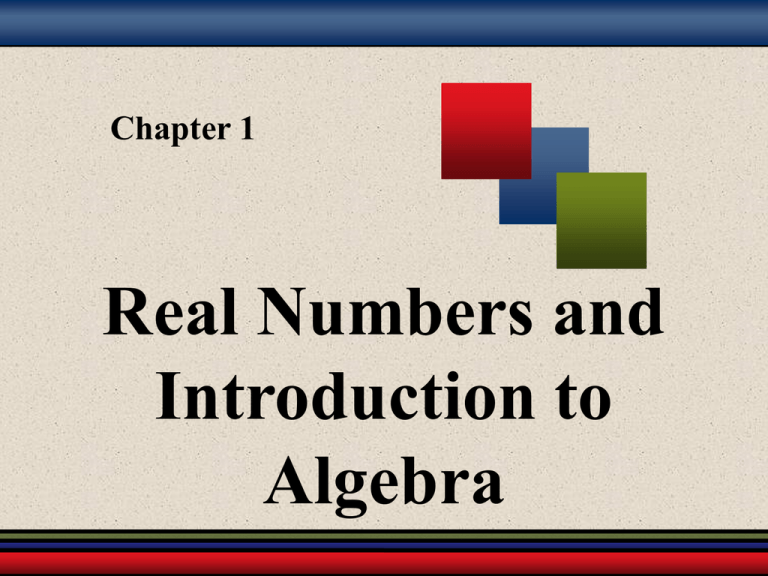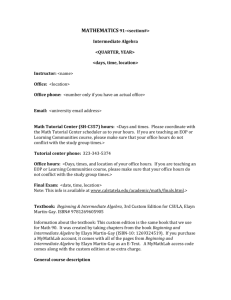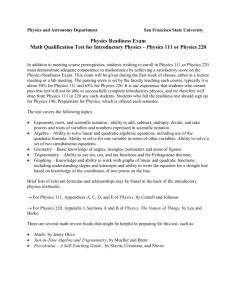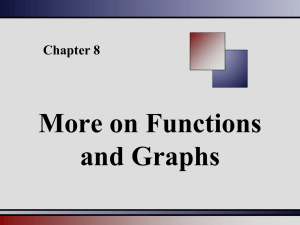Chapter 1: Real Numbers & Introduction to Algebra
advertisement

Chapter 1
Real Numbers and
Introduction to
Algebra
Chapter Sections
1.1 – Tips for Success in Mathematics
1.2 – Symbols and Sets of Numbers
1.3 – Exponents, Order of Operations, and Variable
Expressions
1.4 – Adding Real Numbers
1.5 – Subtracting Real Numbers
1.6 – Multiplying and Dividing Real Numbers
1.7 – Properties of Real Numbers
1.8 – Simplifying Expressions
Martin-Gay, Introductory Algebra, 3ed
2
§ 1.1
Tips for Success in
Mathematics
Getting Ready for This Course
Positive Attitude Believe you can succeed.
Scheduling
Be Prepared
Make sure you have time for your
classes.
Have all the materials you need, like a
lab manual, calculator, or other
supplies.
Martin-Gay, Introductory Algebra, 3ed
4
General Tips for Success
Tip
Details
Get a contact person.
Exchange names, phone numbers or e-mail
addresses with at least one other person in class.
Attend all class periods.
Sit near the front of the classroom to make hearing
the presentation, and participating easier.
Do you homework.
The more time you spend solving mathematics, the
easier the process becomes.
Check your work.
Review your steps, fix errors, and compare
answers with the selected answers in the back of
the book.
Learn from your
mistakes.
Find and understand your errors. Use them to
become a better math student.
Continued
Martin-Gay, Introductory Algebra, 3ed
5
General Tips for Success
Tip
Details
Get help if you need it.
Ask for help when you don’t understand something.
Know when your instructors office hours are, and
whether tutoring services are available.
Organize class materials.
Organize your assignments, quizzes, tests, and notes
for use as reference material throughout your course.
Read your textbook.
Review your section before class to help you
understand its ideas more clearly.
Ask questions.
Speak up when you have a question. Other students
may have the same one.
Hand in assignments on
time.
Don’t lose points for being late. Show every step of
a problem on your assignment.
Martin-Gay, Introductory Algebra, 3ed
6
Using This Text
Resource
Details
Practice Problems.
Try each Practice Problem after you’ve finished its
corresponding example.
Chapter Test Prep Video CD.
Chapter Test exercises are worked out by the
author, these are available off of the CD this book
contains.
Lecture Video CDs.
Exercises marked with a CD symbol are worked
out by the author on a video CD. Check with your
instructor to see if these are available.
Symbols before an exercise
set.
Symbols listed at the beginning of each exercise
set will remind you of the available supplements.
Objectives.
The main section of exercises in an exercise set is
referenced by an objective. Use these if you are
having trouble with an assigned problem.
Continued
Martin-Gay, Introductory Algebra, 3ed
7
Using This Text
Resource
Details
Icons (Symbols).
A CD symbol tells you the corresponding exercise
may be viewed on a video segment. A pencil
symbol means you should answer using complete
sentences.
Integrated Reviews.
Reviews found in the middle of each chapter can
be used to practice the previously learned concepts.
Use Chapter Highlights, Chapter Reviews,
End of Chapter Opportunities. Chapter Tests, and Cumulative Reviews to help
you understand chapter concepts.
Study Skills Builder.
Read and answer questions in the Study Skills
Builder to increase your chance of success in this
course.
The Bigger Picture.
This can help you make the transition from
thinking “section by section” to thinking about
how everything corresponds in the bigger picture.
Martin-Gay, Introductory Algebra, 3ed
8
Getting Help
Tip
Details
Get help as
soon as you
need it.
Material presented in one section builds on your understanding
of the previous section. If you don’t understand a concept
covered during a class period, there is a good chance you won’t
understand the concepts covered in the next period.
For help try your instructor, a tutoring center, or a math lab. A
study group can also help increase your understanding of
covered materials.
Martin-Gay, Introductory Algebra, 3ed
9
Preparing for and Taking an Exam
Steps for Preparing for a Test
1.
2.
3.
4.
5.
6.
Review previous homework assignments.
Review notes from class and section-level quizzes you have taken.
Read the Highlights at the end of each chapter to review concepts and
definitions.
Complete the Chapter Review at the end of each chapter to practice the
exercises.
Take a sample test in conditions similar to your test conditions.
Set aside plenty of time to arrive where you will be taking the exam.
Continued
Martin-Gay, Introductory Algebra, 3ed
10
Preparing for and Taking an Exam
Steps for Taking Your Test
1.
2.
3.
4.
5.
Read the directions on the test carefully.
Read each problem carefully to make sure that you answer the question
asked.
Pace yourself so that you have enough time to attempt each problem on the
test.
Use extra time checking your work and answers.
Don’t turn in your test early. Use extra time to double check your work.
Martin-Gay, Introductory Algebra, 3ed
11
Managing Your Time
Tips for Making a Schedule
1.
2.
3.
4.
5.
6.
Make a list of all of your weekly commitments for the term.
Estimate the time needed and how often it will be performed, for each item.
Block out a typical week on a schedule grid, start with items with fixed time
slots.
Next, fill in items with flexible time slots.
Remember to leave time for eating, sleeping, and relaxing.
Make changes to your workload, classload, or other areas to fit your needs.
Martin-Gay, Introductory Algebra, 3ed
12
§ 1.2
Symbols and Sets of
Numbers
Set of Numbers
• Natural numbers – {1, 2, 3, 4, 5, 6 . . .}
• Whole numbers – {0, 1, 2, 3, 4 . . .}
• Integers – {. . . –3, -2, -1, 0, 1, 2, 3 . . .}
• Rational numbers – the set of all numbers that can
be expressed as a quotient of integers, with
denominator 0
• Irrational numbers – the set of all numbers that
can NOT be expressed as a quotient of integers
• Real numbers – the set of all rational and irrational
numbers combined
Martin-Gay, Introductory Algebra, 3ed
14
Equality and Inequality Symbols
Symbol
a=b
ab
a<b
a>b
ab
ab
Meaning
a is equal to b.
a is not equal to b.
a is less than b.
a is greater than b.
a is less then or equal to b.
a is greater than or equal to b.
Martin-Gay, Introductory Algebra, 3ed
15
The Number Line
A number line is a line on which each point is
associated with a number.
–5 –4 –3 –2 –1
– 4.8
0
1
2
3
4
5
1.5
Negative
numbers
Positive
numbers
Martin-Gay, Introductory Algebra, 3ed
16
Order Property for Real Numbers
For any two real numbers a and b, a is less than b if a is to the left of
b on the number line.
• a < b means a is to the left of b on a number line.
• a > b means a is to the right of b on a number line.
Example
Insert < or > between the following pair of numbers to make a true
statement.
7
0
8
Martin-Gay, Introductory Algebra, 3ed
17
Absolute Value
The absolute value of a real number a, denoted by |a|,
is the distance between a and 0 on the number line.
| – 4| = 4
Symbol for
absolute
value
|5| = 5
Distance of 4
–5 –4 –3 –2 –1
Distance of 5
0
1
2
3
4
Martin-Gay, Introductory Algebra, 3ed
5
18
§ 1.3
Exponents, Order of
Operations, and Variable
Expressions
Using Exponential Notation
We may use exponential notation to write products in
a more compact form.
2 2 2 2 2 can be written as 2 5
Expression
In Words
32
33
34
“three to the second power” or “three squared.”
“three to the third power” or “three cubed”
“three to the fourth power”
Example
Evaluate 26.
26 2 2 2 2 2 2
64
Martin-Gay, Introductory Algebra, 3ed
20
Using the Order of Operations
Order of Operations
1. Perform all operations within parentheses ( ),
brackets [ ], or other grouping symbols such as
fraction bars or square roots.
2. Evaluate any expressions with exponents.
3. Multiply or divide in order from left to right.
4. Add or subtract in order from left to right.
Martin-Gay, Introductory Algebra, 3ed
21
Using the Order of Operations
Example
Evaluate:
693
32
693
32
693
(9)
6 (3)
9
9
9
1
Martin-Gay, Introductory Algebra, 3ed
Write 32 as 9.
Divide 9 by 3.
Add 3 to 6.
Divide 9 by 9.
22
Evaluating Algebraic Expressions
Definition
Example
Variable: A letter to
represent all the numbers
fitting a pattern.
Algebraic Expression: A
combination of numbers,
letters (variables), and
operation symbols.
Evaluate: 7 + 3z when z = – 3
7 3z 7 3(3)
7 (9)
7 9
2
Evaluating the Expression:
Replacing a variable in an
expression by a number and
then finding the value of the
expression
Martin-Gay, Introductory Algebra, 3ed
23
Determining Whether a Number is a Solution
Definition
Example
Solving: In an equation
Is -7 a solution of: a + 23 = –16?
containing a variable,
finding which values of
a 23 16
the variable make the
(7) 23 16
equation a true statement.
Solution: In an equation,
a value for the variable
that makes the equation a
true statement.
– 7 is not a solution.
Martin-Gay, Introductory Algebra, 3ed
24
Translating Phrases
Addition
(+)
sum
plus
added to
more than
increased by
total
Subtraction
(–)
difference
minus
subtract
less than
decreased by
less
Multiplication
(·)
product
times
multiply
multiplied by
of
double/triple
Martin-Gay, Introductory Algebra, 3ed
Division
()
quotient
divide
shared equally
among
divided by
divided into
25
Translating Phrases
Example
Write as an algebraic expression. Use x to represent “a number.”
a.) 5 decreased by a number
b.) The quotient of a number and 12
a.) In words:
Translate:
5
5
decreased by
–
a number
x
The quotient of
b.) In words:
Translate:
a number
x
and
12
x
12 or
12
Martin-Gay, Introductory Algebra, 3ed
26
§ 1.4
Adding Real Numbers
Adding Real Numbers
Adding 2 numbers with the same sign
• Add their absolute values.
• Use common sign as sign of sum.
Adding 2 numbers with different signs
• Take difference of absolute values (smaller
subtracted from larger).
• Use the sign of larger absolute value as sign of
sum.
Martin-Gay, Introductory Algebra, 3ed
28
Additive Inverses
Opposites or additive inverses are two numbers the
same distance from 0 on the number line, but on
opposite sides of 0.
The sum of a number and its opposite is 0.
If a is a number, – (– a) = a.
Example
Add the following numbers.
(–3) + 6 + (–5) = –2
Martin-Gay, Introductory Algebra, 3ed
29
§ 1.5
Subtracting Real
Numbers
Subtracting Real Numbers
Subtracting real numbers
• Substitute the opposite of the number being
subtracted
• Add.
• a – b = a + (– b)
Example
Subtract the following numbers.
(– 5) – 6 – (– 3) = (– 5) + (– 6) + 3 = – 8
Martin-Gay, Introductory Algebra, 3ed
31
Complementary Angles
o
Complementary angles are two angles whose sum is 90 .
Example
Find the measure of the following complementary
angles.
x + 150 – 2x = 90
150 – x = 90
– x = – 60
x
150 – 2x
x = 60° and 150 – 2x = 30°
Martin-Gay, Introductory Algebra, 3ed
32
Supplementary Angles
o
Supplementary angles are two angles whose sum is 180 .
Example
Find the measure of the following supplementary
angles.
x + x + 78 = 180
2x + 78 = 180
2x = 102
x
x + 78
x = 51° and x + 78 = 129°
Martin-Gay, Introductory Algebra, 3ed
33
§ 1.6
Multiplying and
Dividing Real Numbers
Multiplying or Dividing Real Numbers
Multiplying or dividing 2 real numbers
with same sign
• Result is a positive number
Multiplying or dividing 2 real numbers
with different signs
• Result is a negative number
Martin-Gay, Introductory Algebra, 3ed
35
Multiplying or Dividing Real Numbers
Example
Find each of the following products.
4 · (–2) · 3 = –24
(–4) · (–5) = 20
Martin-Gay, Introductory Algebra, 3ed
36
Multiplicative Inverses (Reciprocals)
If b is a real number, 0 · b = b · 0 = 0.
Multiplicative inverses or reciprocals are two
numbers whose product is 1.
The quotient of any real number and 0 is undefined.
a
0
The quotient of 0 and any real number = 0.
0
a
a0
Martin-Gay, Introductory Algebra, 3ed
37
Simplifying Real Numbers
If a and b are real numbers, and b 0,
a
a
a
b
b
b
Example
Simplify the following.
86
14
14
8 3(2)
8 (6)
3
9 2(3) 9 (6) 9 6 3
Martin-Gay, Introductory Algebra, 3ed
38
§ 1.7
Properties of Real
Numbers
Commutative and Associative Property
Commutative property
• of addition: a + b = b + a
• of multiplication: a · b = b ·
a
Associative property
• of addition: (a + b) + c = a + (b
+ c)
• of multiplication: (a · b) · c = a ·
(b · c)
Martin-Gay, Introductory Algebra, 3ed
40
Distributive Property
Distributive property of multiplication over
addition
• a(b + c) = ab + ac
Identities
• for addition: 0 is the identity since
a + 0 = a and 0 + a = a.
• for multiplication: 1 is the identity since
a · 1 = a and 1 · a = a.
Martin-Gay, Introductory Algebra, 3ed
41
Inverses
Inverses
• For addition: a and –a are inverses since
a + (– a) = 0.
• For multiplication: b and 1b are inverses (b 0)
since b ·1b = 1.
Martin-Gay, Introductory Algebra, 3ed
42
§ 1.8
Simplifying Expressions
Terms
A term is a number, or the product of a number and
variables raised to powers – (the number is called a
coefficient)
Examples of Terms
7
(coefficient is 7)
5x3
(coefficient is 5)
4xy2
(coefficient is 4)
z2
(coefficient is 1)
Martin-Gay, Introductory Algebra, 3ed
44
Like Terms
Like terms contain the same variables raised to the
same powers
You can combine like terms by adding or
subtracting them (this is not true for unlike terms)
To combine like terms, add or subtract the
numerical coefficients (as appropriate), then
multiply the result by the common variable factors
Martin-Gay, Introductory Algebra, 3ed
45
Combining Like Terms
Examples of Combining Terms
Terms Before Combining
6x2 + 7x2
19xy – 30xy
13xy2 – 7x2y
After Combining Terms
13x2
-11xy
Can’t be combined
(since the terms are not
like terms)
Martin-Gay, Introductory Algebra, 3ed
46





